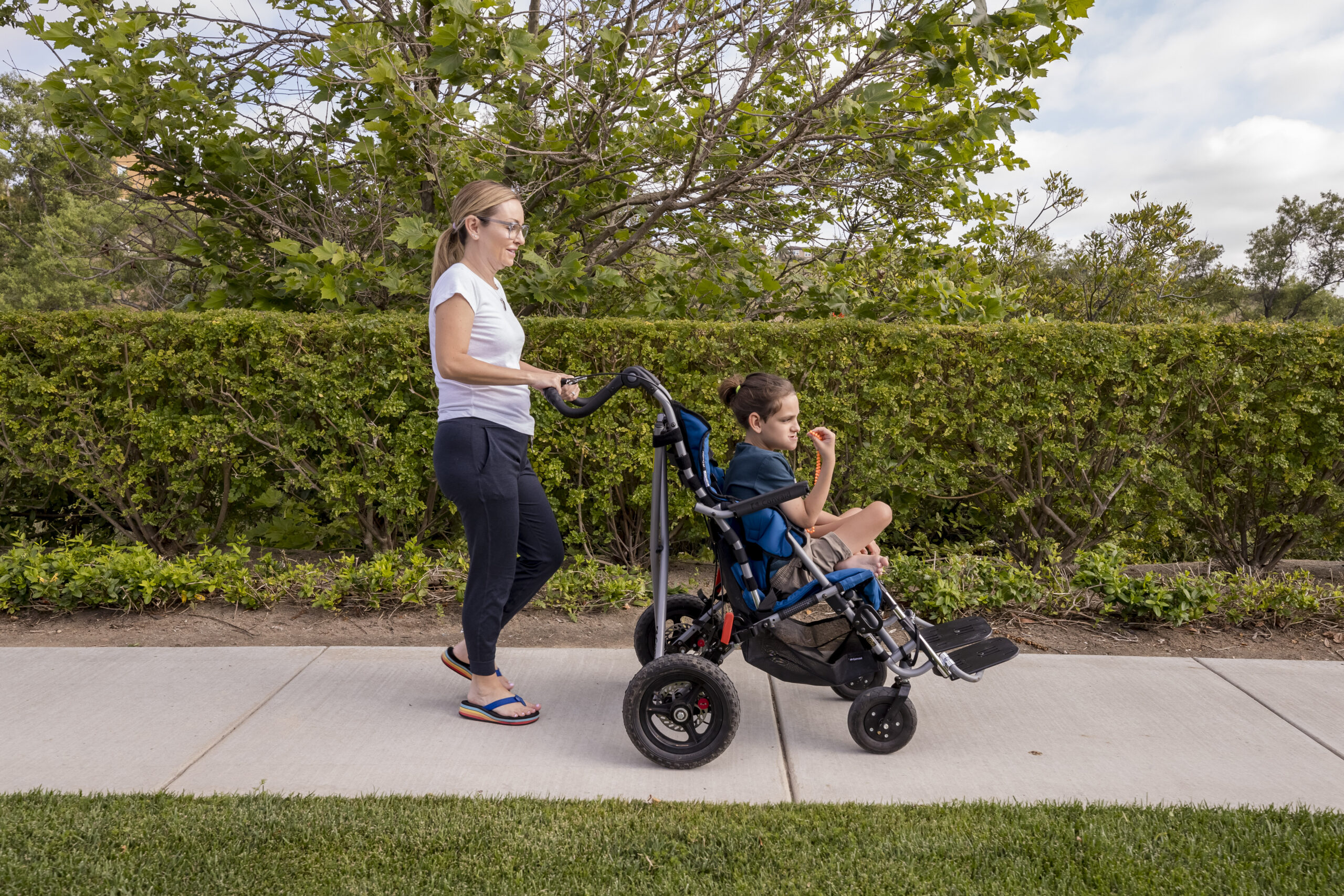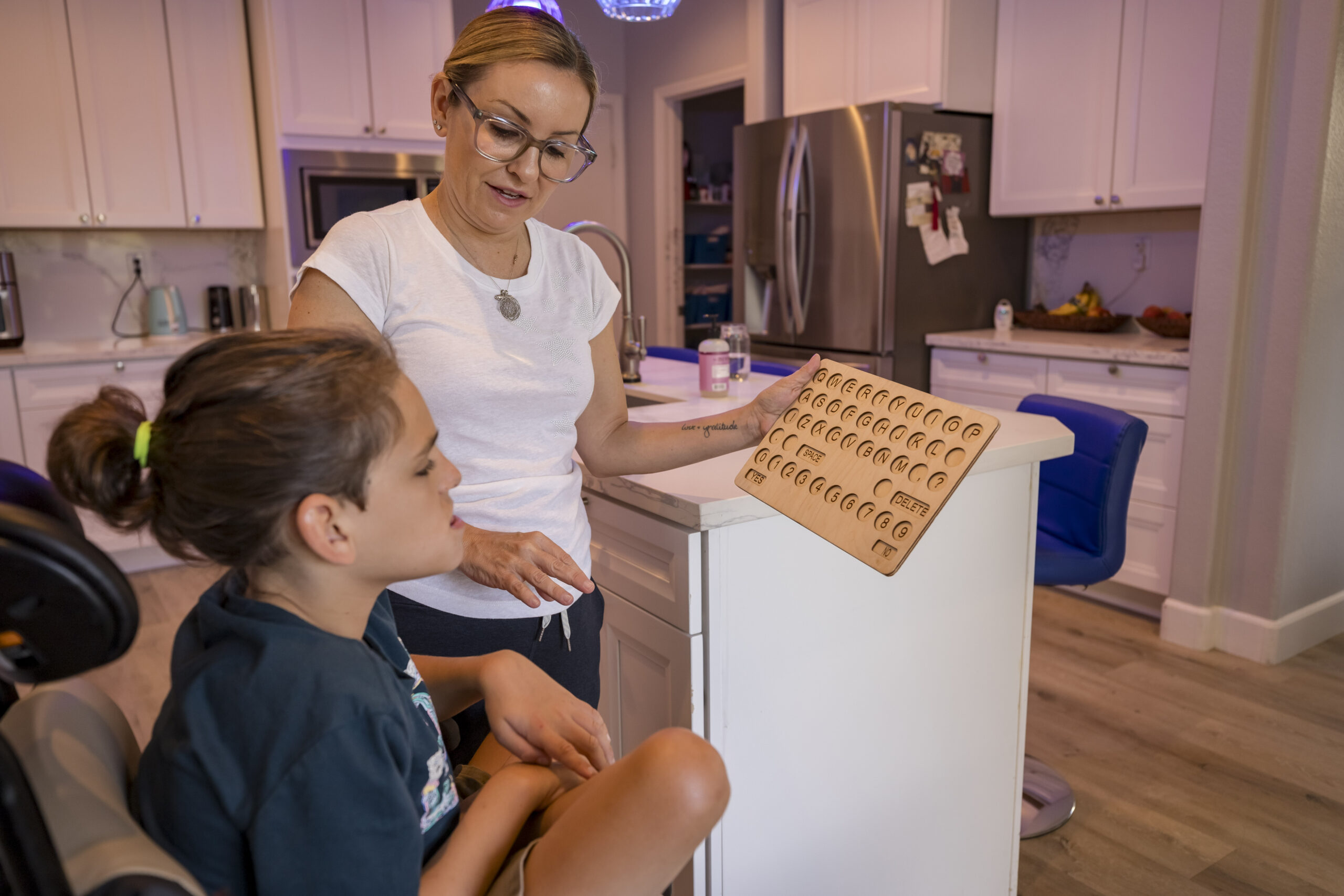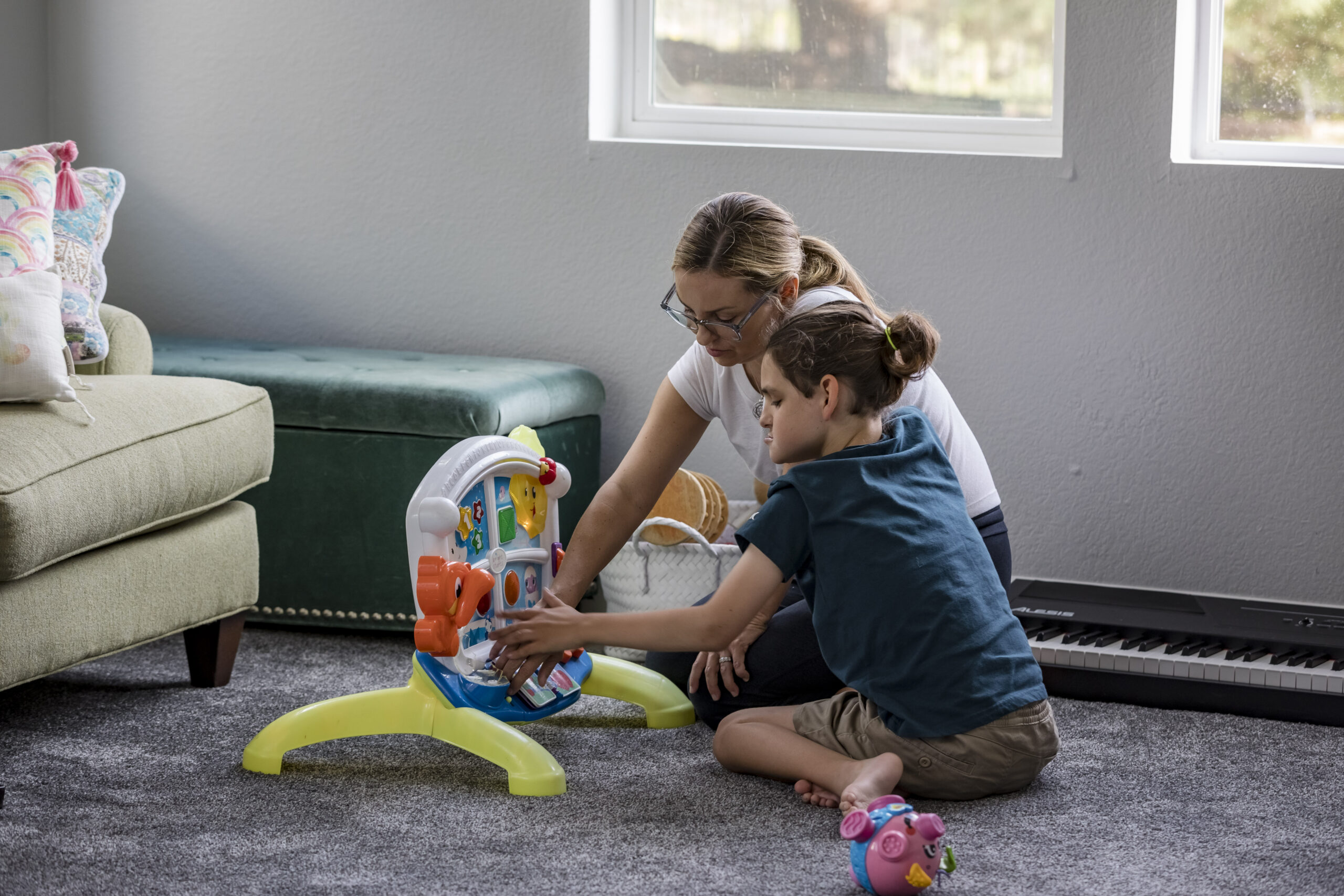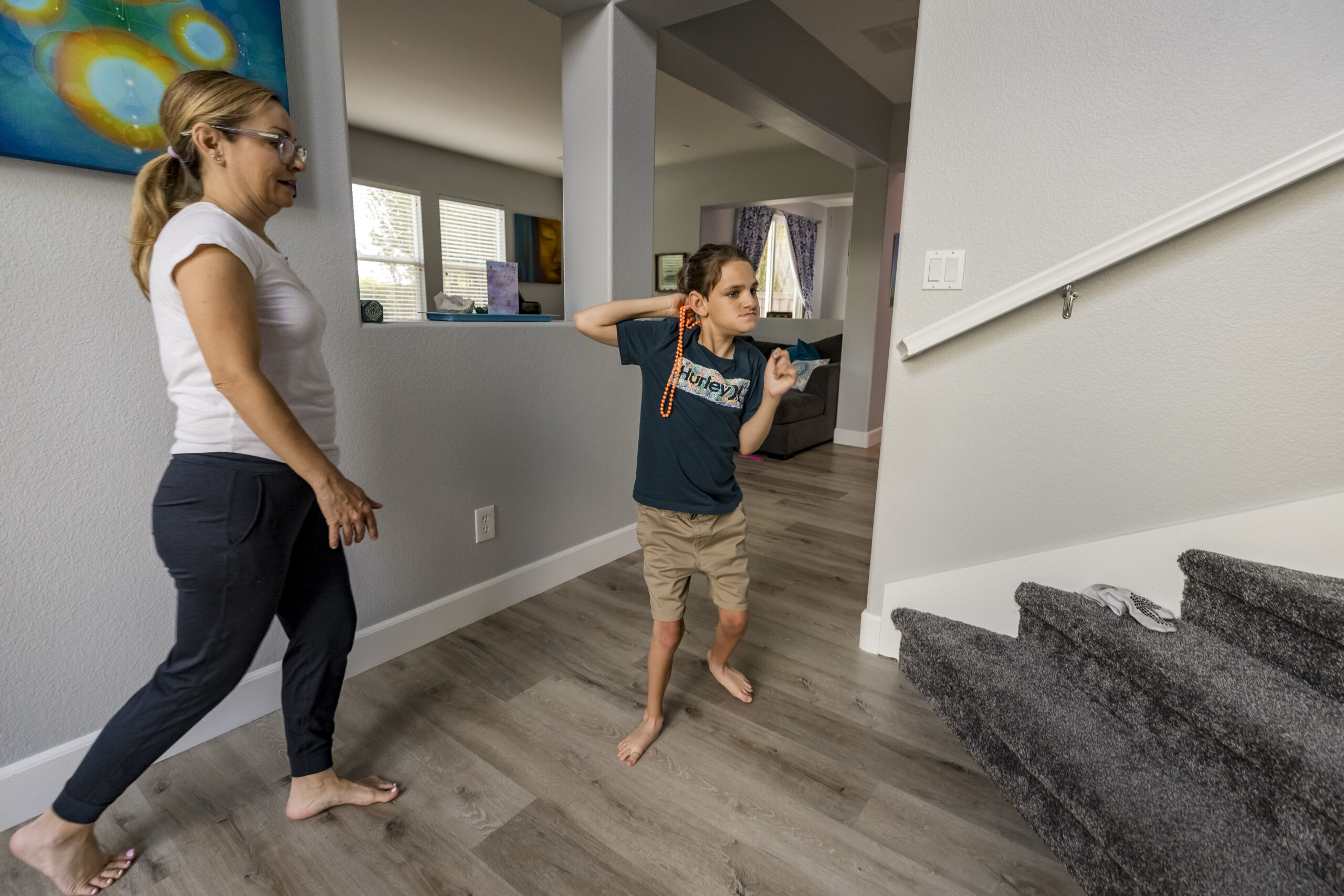
A teenager faced constant seizures. Could a drug developed just for him stop them?
SAN DIEGO — Connor Dalby’s shrieks filled his playroom, and the rest of the house. The teenager hushed when his mom, Kelley, asked a long-coming question: “Are you ready for the big day tomorrow?”
He typed “yes” on his wooden letterboard, his only means to put his thoughts into words. But then he resumed shrieking, the prelude to a pair of seizures that, later that night, caused his toes to curl, his eyes to dilate and his body to spasm. It had been like this for 14 years.
“I’ve been fighting for my son his entire life with all the energy in me,” Kelley said. “He’s smart and tenacious but trapped in a body that doesn’t cooperate.”
The next day, doctors injected Connor with an experimental treatment that had been tailored just for him. After years of dead ends and delays, the hope was that the drug could patch over the ultra-rare genetic mutation that causes Connor’s seizures, development delays and a movement disorder.
Past and future
Last March, Connor became one of the first patients to be treated by the n-Lorem Foundation, a nonprofit set up to develop medicines for diseases affecting 30 or fewer patients.
There’s little profit in making a medicine for such a tiny population — an estimated 95% of rare diseases lack a treatment, according to the advocacy group Global Genes. And many children never live long enough to be diagnosed, as their parents become mired in diagnostic odysseys.
Connor’s medicine only arrived because Kelley ignored neurologists who viewed her son as a lost cause. She paid for exhaustive genetic testing that revealed Connor’s genetic glitch. Even after his disease was found, geneticists told her it would be 100 years before a treatment was developed.
But Connor, after long symbolizing personalized medicine’s failures, has come to represent its promise. Kelley’s plea to help her son inspired a former biotech executive to start n-Lorem. It funded and created Connor’s medicine, and the nonprofit eventually wants to do the same for thousands of patients. If n-Lorem succeeds, it will show a path forward for the many other patients like Connor. If it fails, it’s a major setback in the quest to standardize tailored treatments.
Connor’s family allowed Endpoints News access to his life as the n-Lorem Foundation developed his medicine. This story is a product of interviews that spanned more than three years.
The lowest of lows
N-Lorem’s roots go back to 2017, when Kelley and another parent asked Stanley Crooke, then the CEO of Ionis Pharmaceuticals, to develop a medicine for the culprit behind their children’s seizures: a mutation in the gene SCN2A that plays a key role in transmitting electrical signals in the brain.
In response, Crooke said the known prevalence of SCN2A patients was too small to be pursued commercially. (Ionis later supported drug discovery efforts.) But the conversation got him thinking about a better way to create drugs for ultra-rare diseases.
Ionis had spent decades honing antisense oligonucleotides that interrupt disease-causing proteins. Its first antisense breakthrough arrived in 2016 with the approval of Spinraza, which transformed treatment for spinal muscular atrophy, once a death sentence for babies.
Connor Dalby prepares to type on his letterboard, his only way to put his thoughts into words.
Click on the image to see the full-sized version
Crooke believed that Ionis’ technology could be quickly tailored to other rare diseases. Antisense drugs are made up of the building blocks of genetic code, and these blocks can be easily arranged in varying sequences.
“The question actually shifted for me to a moral question,” Crooke said. “How could I not do it?”
In 2019, Crooke announced plans to step down as the head of Ionis to focus on n-Lorem. That year, he shared n-Lorem’s plans with Kelley after they met again by chance at a scientific conference in San Diego.
It was good timing. In the two years between their first meeting and when they reconnected, further genetic testing found that Connor’s SCN2A variant was one-of-a-kind, and he wasn’t a candidate for a potential drug in development for the broader mutation. He was later accepted as n-Lorem’s first patient.
“I went from experiencing the lowest of lows to disbelief that someone would create a drug for just one person,” Kelley said.
Balancing act
As a toddler, Connor barely responded when Kelley waved a hand in front of his face. He wasn’t expected to live past his 4th birthday. Not only did he survive, but his frequent physical and neurodevelopment exercises resulted in hard-won abilities.
In 2021, n-Lorem scientists were busy cooking up a medicine to accelerate his progress, and save him from the seizures. A dozen miles from the nonprofit’s headquarters, Connor and Kelley shared their hopes for the treatment in their kitchen.
“Reduce seizures first and foremost,” Kelley said. A ballad from Ed Sheeran, Connor’s favorite musician, played. Sitting in a high chair, Connor typed on the letterboard that he wanted to “walk and talk.”
The letterboard had provided a window into a rich interior world that his family didn’t know existed. Months earlier, Connor awed his mom by describing her as kind. He joked with his brothers, Cameron and Chase. He reeled off reasons for why he loves the beach.
After Kelley coaxed a muffin piece into Connor’s mouth, he grew restless. He shrieked. Kelley tugged Connor’s ear. It was hot to the touch, indicating a seizure could be coming.
Kelley lifted Connor from the high chair. With her assistance, they walked outside into a cloudless fall sunset. Connor stopped shrieking.
During a phone interview a year later, Kelley expressed gratitude that n-Lorem had freed her from the burden of finding a treatment. But a medicine that was supposed to be delivered within 18 months was still in development. The seizures continued unabated.
“I’m just needing some sort of timeline,” Kelley said at the time.
All told, it took more than three years to develop and get a medicine to Connor, in part because n-Lorem’s scientists struggled with a tricky balancing act of hindering Connor’s gene mutation while leaving a healthy copy of the gene alone.
Scientists tested out a litany of compounds against reengineered cells that approximated Connor’s brain. Eventually they zeroed in on one medicine, and delivered it to Rady Children’s Hospital-San Diego.
Not nearly enough
N-Lorem wants to treat dozens, and eventually thousands, of patients like Connor. The dream, if realized, would make n-Lorem the first organization to scale bespoke medicines.
“They’ve really positioned themselves at the edge of personalized medicine. No one else has the same ambitions for treating so many ultra-rare diseases that companies aren’t touching,” said Suma Babu, a Harvard neurologist who is not affiliated with the nonprofit.
Neither the science nor the business is easy. N-Lorem provides patients with a free lifetime supply of a drug that roughly costs $700,000 to develop and manufacture. It has raised more than $50 million to fund medicines, and companies like Biogen have provided in-kind contributions.
But Crooke acknowledged the financial limits of the philanthropic model. Its waitlist includes more than 100 patients, and growing. He said the nonprofit plans to license findings from custom medicines that might be applicable to more common diseases.
Meghan Halley, a senior research scholar at Stanford’s Center for Biomedical Ethics, said the plan could push the boundaries of n-Lorem’s nonprofit mission. “When licensing a drug that’s relevant to common diseases, their pricing plans matter. Are they thinking about patient access like a nonprofit?” she said.
Crooke said the for-profit companies that license findings should be able to recoup the much larger costs that come with drug development for more common conditions. He argued, essentially, for subsidizing ultra-rare disease patients who otherwise have few options.
“I have no intention of making a profit from these desperate families. But we have to fund what I believe is going to demand from many, many thousands of patients,” Crooke said.
N-Lorem’s approach contrasts with other groups engaged in individualized medicine.
The nonprofit is co-developing medicines with St. Jude Children’s Research Hospital but has otherwise been choosy about partnerships. Crooke believes some labs are creating antisense drugs without the requisite experience.
“They may sound simple. They’re not,” Crooke said. “We’re supporting any group that we think is capable of doing that. And we’re anxious about others that may not have demonstrated that ability.”
Doctors and scientists who are part of the N=1 Collaborative — an international group named after a clinical trial for one patient — argue that n-Lorem is far from alone in creating quality antisense drugs.
Boston Children’s Hospital’s Timothy Yu, who is a member of the N=1 Collaborative’s steering committee, spearheaded the first custom medicine in 2017. He says he constantly receives emails from families pleading for help.
So far, his team at Boston Children’s has managed to develop custom medicines for six patients, and is searching for ways to scale. Likewise, Nobel Prize winner Jennifer Doudna wants to create a blueprint for developing gene therapies aimed at rare conditions.
“I’m really hugely pleased to see the progress,” Yu said of the wider field. “And I’m also starkly aware that it’s not nearly enough.”
Paradigm shift
It’s not just the science and economics that are challenging. There’s also little regulatory precedent at the FDA for approving drugs for such tiny populations.
Peter Marks, the FDA’s director of the Center for Biologics Evaluation and Research, has been vocal about the agency showing more flexibility across a range of rare diseases.
In June, he overruled his staff to approve an expansion of Sarepta’s treatment for Duchenne muscular dystrophy. The gene therapy now covers all patients despite the drug failing a late-stage clinical trial.
And treatments for much rarer conditions than Duchenne muscular dystrophy can be even tougher to evaluate, especially when there aren’t enough patients to carry out a placebo-controlled study.
Kelley Dalby and Connor fiddle with a toy in his playroom.
Click on the image to see the full-sized version
In an interview with Endpoints, Marks said the agency is trying to find the right regulatory balance as more ultra-rare diseases emerge.
“So we have a fair amount we can lean in on,” Marks said. “But I think we have to be careful that what we don’t like to do is take the bar and bring it down so low that we actually do patients a disservice, because stuff starts to get over the finish line that actually doesn’t really bring much if any clinical benefit.”
Representatives for EveryONE Medicines, a private company dedicated to custom drugs, said US, UK and EU regulators are moving toward relaxing standards to speed development. The trend, the company believes, will make bespoke medicines more investable.
For Connor’s drug, the FDA initially demanded a test to measure whether there was a biological sign the drug was working at the molecular level. The agency ultimately agreed with the argument that it wasn’t feasible to develop a test for such a rare case, and let the study go ahead.
Giant steps
After doctors at Rady Children’s Hospital-San Diego injected Connor with the antisense drug, he slept in a hospital bed. Beside him, Kelley cried with happiness.
“Oh my God, we really accomplished this,” she remembers saying.
Two subsequent doses slashed Connor’s seizures, according to electroencephalogram readings that pick up on abnormal brain waves and Kelley’s seizure logs.
That type of careful monitoring is typical of epilepsy studies, but also serves to guard against Kelley’s vulnerability to the placebo effect. She’s much more involved than parents typically are during a drug study.
But there seemed to be other clear signs the drug was helping. Connor typed on his wooden keyboard that his brain felt calmer. He slept better. He didn’t burst into hysterics as much.
Last month, weak sunlight filtered into the playroom at the Dalby family’s home. Kelley and Connor laughed as he pushed buttons on a toy.
She gave him a hand up, and Connor stepped across a plush rug, and then laminate flooring. Kelley beamed. He had been walking without assistance for two weeks, after never taking more than a few steps on his own.
In a hallway, Connor looked back and reached for his mom’s hand. “You got it. Balance yourself and keep going. I’m going to let go again,” Kelley said.
Connor paced the ground-level rooms, back and forth. “He’s showing off,” Kelley said with a laugh.
Olivia Kim-McManus, a neurologist at Rady Children’s Hospital-San Diego and the principal investigator for the study, said in a video interview the medicine appeared to be meeting the two primary study goals: reduce seizures and improve Connor’s movement disorder. Walking wasn’t expected.
“There’s certain things that you think you might see. It wasn’t really on my radar that he would be doing that,” she said.
Plans call for increasing the dose of the medicine over time. But just before this story was published, Kelley told Endpoints that she was trying to get the administration of the drug moved to every month, instead of every few months. The effects, including Connor walking unassisted, start to wane after 30 days.
“He’s really up and down, and I’m really upset,” Kelley said.
In a statement forwarded by a spokesperson, n-Lorem said it will continue to increase the dose and adjust the frequency to maximize the drug’s benefit.
“Seeing a waning of benefit at such a low dose as we move into the next treatment window is to be expected. What we find so remarkable is the magnitude of his response at such a low dose. This gives us great hope that this medicine could really change the course of his disease,” the group said.
So far, n-Lorem has created 17 drugs, some of which have been administered to patients, while other drugs are undergoing regulatory review. The nonprofit declined to say how many people have received medicines. A final verdict on these treatments, including Connor’s medicine, won’t be rendered until more time passes and the results are published in a peer-reviewed journal. And many more patients await treatment.
The future, while slow to arrive, could mean fewer diagnostic odysseys, and an easier path for custom medicines. From n-Lorem to Boston Children’s and beyond, efforts are afoot to pair exhaustive newborn screening with bespoke drug development. That way, diseases are halted before unleashing the worst symptoms.
In San Diego, there’s no reversing time for Connor, who recently turned 15. But Kelley is hopeful.
“It feels like I’m seeing more of him,” she said.


